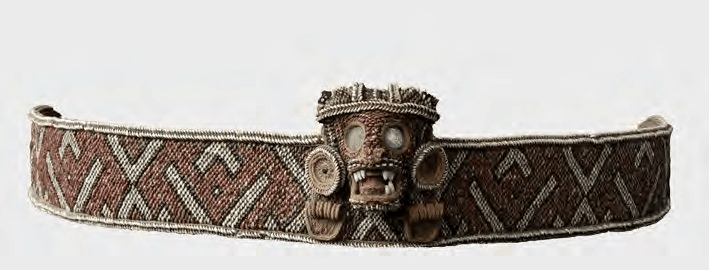Although her account is so brief and problematic, L'Ayiti des indiens: textes d'historiens by Odette Roy Fombrun includes a short account of a Vodou service to Anacaona as a lwa. Visiting an area in the mornes, the habitation Badè, which she did not specify the location of, Roy Fombrun saw someone possessed by Anacaona. In addition, the lakou featured a "maison" of Anacaona and honored her every year in early December. Unsurprisingly, when Anacaona possessed or mounted someone, they adopted the attitude of a queen. She received offerings of perfume and flowers, too. The other detail Roy Fombrun reported is that Anacaona was represented by a painting placed against a ship symbolizing Agwe. Apparently the painting of Anacaona was supported by an image of Erzulie Freda, which might explain why the offerings to Anacaona were the same as those of the other lwa. Perhaps this lakou's commemoration of Anacaona, like in the 21 Divisions in the DR, associated her with water (hence the Agwe connection) and with the beauty and sensuality of Erzulie Freda? At the tiny "maison" of Anacaona at this lakou, offerings of clothes were made to the cacica. Furthermore, as if to prove that this area of Haiti was populated by descendants of Indians, Roy Fombrun remarked that the inhabitants of the area en route to the lakou had Indian features.
What particularly stands out to us is the final comment of the author. She claims Gerard Fombrun owned a cigar store Indian that had been found in a houmfort. This indicates that, like some Espiritismo groups and in 21 Divisions Vodu, some Vodou temples in Haiti were using Native American statues imported from the US and incorporating them into ceremonies for Indian spirits. Like their Dominican counterparts, the particular temple visited by Roy Fombrun apparently honored Anacaona but in a way that suggests she was given some of the attributes of Erzulie Freda. The association with Agwe may be a nod to the similar association of Indian spirits with water in Dominican Vodou. However, this is the only account we have encountered suggesting such a thing. Usually water spirits like the Simbi have African antecedents or origins. However, in this case, it is possible that Anacaona was incorporated as a lwa based on Erzulie Freda and there may have been an influence from 21 Divisions. The fact that Gerard Fombrun apparently possessed a cigar store Indian that was once in a houmfort tells us that the incorporation of Indian spirits into Haitian Vodou may have been a little more widespread than one thinks, too. Geo Riply's work on Dominican Vodou suggests a Dominican influence here. Indeed, the Indian Division is associated with Saint Nicholas, whose feast day happens to be the same day Anacaona is commemorated at the site visited by Roy Fombrun. Moreover, Martha Ellen Davis's work indicates a preponderance of Indian spirits in the Dominican Southwest, probably the region close to the area visited by Roy Fombrun.
Sadly, without knowing more about the specific details of the area visited by Roy Fombrun, all we can say is that Anacaona was, or perhaps still is, honored in Haitian Vodou to some unknown extent. It appears to be in a way very similar to that in the Dominican Republic, which makes it likely that the area visited by Roy Fombrun was probably near or not too far from the Dominican Southwest. The offering made to Anacaona in a "grotte" does bring to mind Taino customs, although this worship of Anacaona undoubtedly blends African influences with whatever vestiges of Taino spirituality survive. And while there remains more work to be done on this, perhaps Haitian Vodou traditions also associated Indian spirits with the water. We have the evidence of Deita Guignard's La Légende des Loa: Vodou Haïtien that Maitre Clermaille was supposedly an Indian of the island, a Taino. However, earlier traditions recorded by Simpson contradict that, suggesting General Clermeil or Clermaille was believed by northern peasants to have been a cruel Frenchman. Others write that he was the father, not the husband, of his daughter, also associated with the sea and people with light skin.

No comments:
Post a Comment